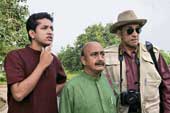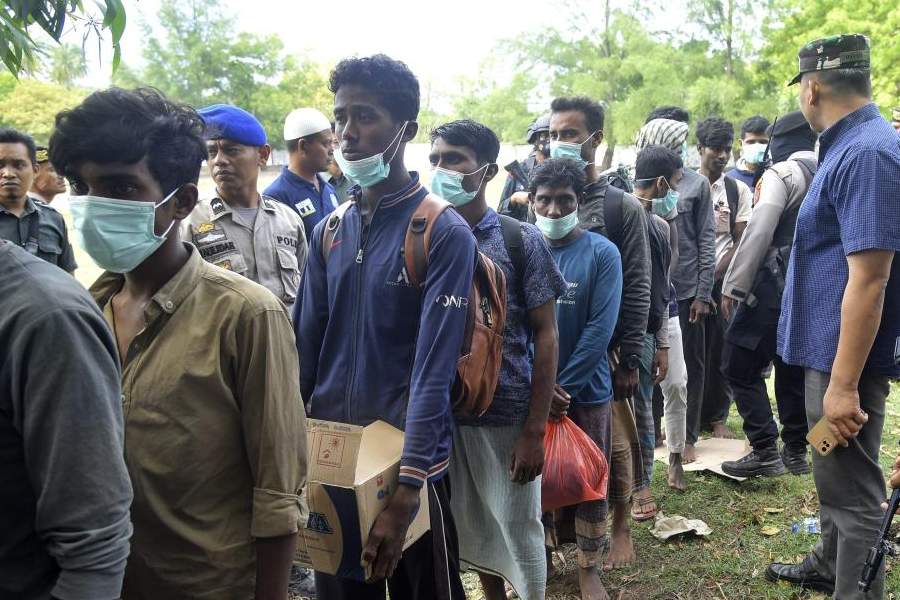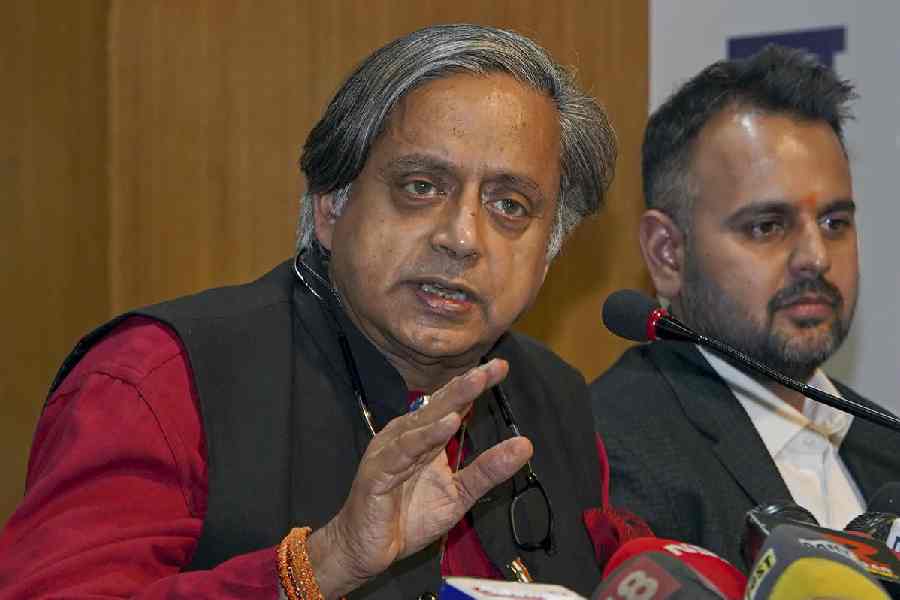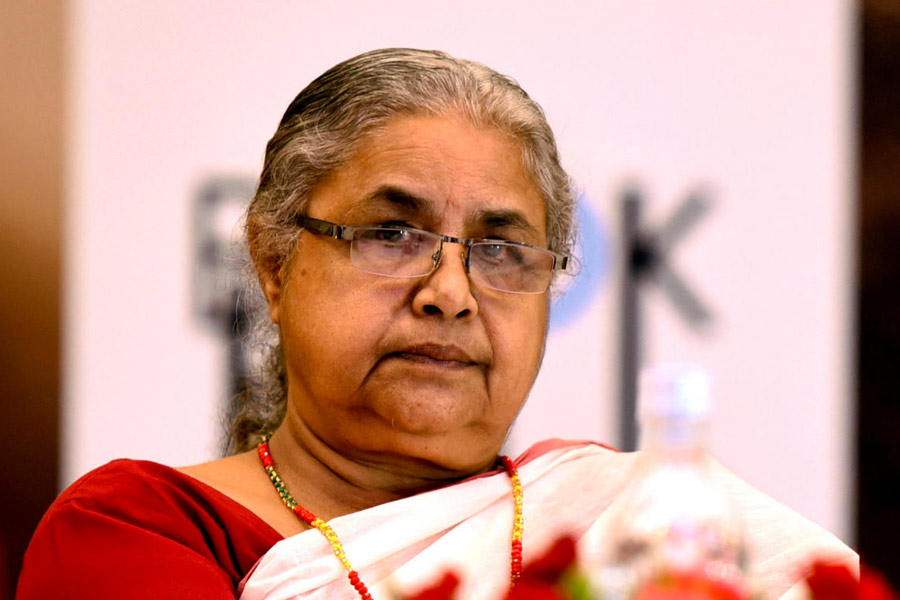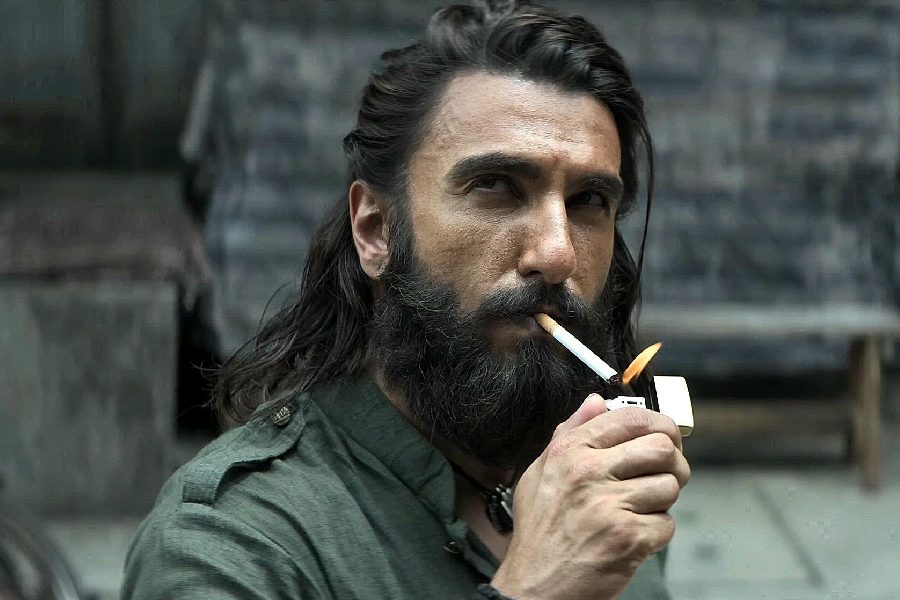 |
 |
 |
| A still from Kailase Kelenkari; (below) Soumitra Chatterjee as Feluda with Santosh Dutta as Jatayu; and (bottom) a Feluda book cover |
Horipodobabu, the faithful driver, is still there, but Lalmohanbabu steps down from a green Hyundai Santro, instead of the green Ambassador, which one thought was inalienable from him.
In Kailase Kelenkari, the film by Sandip Ray that released this Friday, Lalmohanbabu, alias Jatayu, well-known writer of sensational novels, and one of Feluda’s two admiring attendants, has changed his car. And Feluda, or Pradosh C. Mitter, the famous Bengali descendant of Sherlock Holmes, the ace private investigator generations of Bengalis have hero-worshipped since Satyajit Ray created him in 1965, has been upgraded. Sandip says Feluda had to move with the times.
Not that Feluda was behind the times ever. He was happening enough always. Long before the Internet and infotainment, Feluda was the seducer of young minds. In the Seventies and Eighties, Bengali children learnt about the world from him. He was that irresistible combination of authority and attraction: a glamorous teacher who stole children’s minds.
Geometry
It is from Feluda that his young, and on some occasions, old, readers learnt about Chariots of the Gods. That when Topshe, Feluda’s young cousin and his other doting admirer, spat out of the window— “if you do it again, I will punch you on the head” — the ejected matter descended in a parabolic curve. Geometry. “Have you seen a spider’s web?” Feluda asks in Sonar Kella, an early novel. “There’s such complex geometry in it. It starts as a simple quadrilateral. Then two diagonals divide it into four triangles. Then from the intersection of the two diagonals the spider starts weaving the spiral designs…”
Topshe asks Feluda what geometric structure he (Feluda) resembles. “A many-pointed star,” he says. “And I? Its satellite?” asks Topshe. “You are a point, which the dictionary defines as something that has a position but no extension.”
Feluda was the star. Topshe the mere mortal, was left gazing skywards. Feluda was the lighthouse, a still point in the choppy, tumultuous waters of daily life that Topshe, and his readers, could negotiate so much better with his help. Feluda is, like Sharadindu Bandyopadhyay’s brilliant “satyanveshi” Byomkesh Bakshi, in the best tradition of classical detective fiction, pure reason. He extricates the truth from a web of falsehoods by applying reason. He reinstates morality. Plus, he is about six feet tall, handsome, well-brought-up, well-mannered, slightly arrogant, intelligent, refined, knowledgeable, has a sharp sense of humour, single, male, lives in south Calcutta, with sharp features. “Especially in his sketches,” says Mitul Sarkar, a 34-year-old e-learning consultant. “He is part of the Bengali psyche. He is a Bengali ideal.”
New avatar
In Kailase Kelenkari, the film, Feluda is still as tall. But as Sandip Ray says, he has had to take on many other attributes, while remaining the same. Like the others who belong to his world.
The new Feluda is a study of the problems of an institution updating itself.
So changes there are. Lalmohanbabu still retains Horipodobabu, but probably sold off his “Madrasi” green Ambassador to “upgrade” himself. Or is he now rich enough to maintain two green cars at his Garpar Road address? “Lalmohanbabu always found green soothing and we were told that it was okay to upgrade his car,” says Sandip, adding that any change in the Feluda paradigm is introduced after much consideration and much listening to opinion. Feluda does smoke the iconic Charminar from the yellow packet — but alas! they are so few that they look guilty. Has the doctor advised Feluda to cut down on the nicotine or has the crack detective gone politically correct? Feluda inhabits New Calcutta — of Rajarhat, new constructions, entertainment zones. He is also far more trigger-happy. He fights thugs on several occasions, wounding them severally. He is hands-on. He uses his revolver — Feluda carries a six-shooter Colt — more, the “magajastra” (brain weapon) is less in sight. The greater stress on action is to connect with the contemporary young audience more. Thain thain thain thain thain thain.
And Sidhujyatha, the man who plays big brother Mycroft to Feluda’s Sherlock, the ancient fount of wisdom who also subverts wisdom — “dictionary” is “dekhos nari”, “psychology” is “pishi cholo jai” — the perpetual occupant of his book-lined tenement from which he keeps track of every development in the universe with a Socrates’s disdain and detachment from a position of authority that no one dares to question, not even Feluda, comes down to a snazzy café, usually associated with trendy teenagers, with Feluda, Topshe and Lalmohanbabu! The world does not seek Sidhujyatha out any more. Sidhujyatha has to seek it out to prove his relevance.
But old habits...
As a result, Kailase Kelenkari is a smart, fast-paced watchable adventure, in touch with the times, the smartest Feluda film to have been made by Sandip who also made Baksho-Rohoshyo, a telefilm, and Bombaiyer Bombete, a full-length feature. He repeats the main cast from Bombaiyer Bombete — Sabyasachi Chakraborty as Feluda (smart), Parambrata as Topshe (smart) and Bibhu Bhattacharya as Jatayu (boring and a little crude).
Of course, Sandip does not tamper with the foundation stones. “There are great expectations from Feluda,” he knows. He also knows that while certain things can change, others are simply not to be interfered with. That’s why he makes Feluda hang on to his Charminar, though it’s slightly anachronistic. The packets, if available, are really small in size.
Sandip is also radically conservative about another Feluda trait. He does not give him a mobile phone. Neither do Topshe or Lalmohanbabu get mobiles, for the director feels that would really crack Feluda’s image up. A threat on the mobile phone instead of on the landline would demolish the plot. “We thought that we didn’t need to explain why Feluda is still without a mobile; his audience would understand. But we will have to give him that if it’s necessary in the future,” Sandip concedes. Though he had to do away with the “trunk call”, for many children today would not even have heard of it. He is shooting another Feluda film, Tintoretor Jishu.
And like Sherlock Holmes, Feluda’s character through the years, the books, and the films, by Satyajit (Sonar Kella and Joi Baba Felunath) and Sandip, maintain some other basic rules followed by true detectives. Like Holmes and Watson, Feluda, Topshe and Jatayu have not really aged. This is Dorothy L. Sayers, another revered practitioner of the craft of detective fiction, on Arthur Conan Doyle’s Holmes and Watson, who, she claims, are the descendants of Edgar Allan Poe’s C. Auguste Dupin and his friend: “They are static figures; after 40 years they have not aged or developed in any essential manner, and, despite all ingenious speculation about the number of Dr Watson’s marriages, they remain men with no private lives.” True of Feluda, Topshe and Jatayu — they still belong to the realm of ideas, untouched by women, relationships, real life.
Just another hero?
But despite best efforts, Feluda has lost something in the process. We miss the older Feluda, of Satyajit’s films and the novels.
At an obvious level we miss Soumitra Chatterjee as Feluda, the nearest approximation to Satyajit’s sketches of his hero, though he is sharper than the actor, quite sharp by Bengali standards; and Santosh Dutta as Jatayu, who is irreplaceable. And the pure delight that Satyajit had instilled in Jatayu, both in print and on screen.
When asked to name a creature that flies, only Jatayu could come up with “Bengur!” The animal, he explained, was a combination of badur (bat), hangor (shark) and belun (balloon) — all the things having suggested themselves to his imagination all at once. In the film Sonar Kella, he wants to know how the camels pick out the thorns when they eat thornbushes. Only he can swoop down like that and claim the bhojali in the film, exulting: “Eta aamar (This is mine)!” Only he can say “Hanyes (Hain + Yes)” under pressure; only he can ask “Ginbo?”, combining the Hindi “Ginenge?” and the Bengali “Gunbo?” (Should I count?), when offered a fat wad of notes.
Jatayu offered the innocence that afforded a counterpoint to the world of crime that Feluda challenged. It was because of Jatayu to a great extent that once Feluda solved the crime, the world could be restored to its innocence.
And Sabyasachi Chakraborty is a competent hero, but does he end up being anything more than the other Bengali adventurer-heroes, like Sunil Gangopadhyay’s Kakababu, or Buddhadeb Guha’s Rijuda? Unlikely. Besides, Feluda, as says a 20-something Feluda follower, is “hot”. Though celibate, though untouched by women. Maybe because of that.
The times have not treated Feluda well.
But that may not be all. There are other compulsions that have come with time. Kailase Kelenkari carries in-house product placements. They are cleverly done. “The ad film on a jewellery brand is tongue-in-cheek. It is not to be taken seriously,” stresses Sandip. But cleverly or not, if Feluda is endorsing a product in his film, does the scheme of things remain the same?
Does he still have the absolute moral authority to take on a menacing Maganlal Meghraj, pure evil? The Professor Moriarty to Feluda’s Sherlock? And award him with the final, final sentence of: “Teen maash jail, saat din phaansi?”

